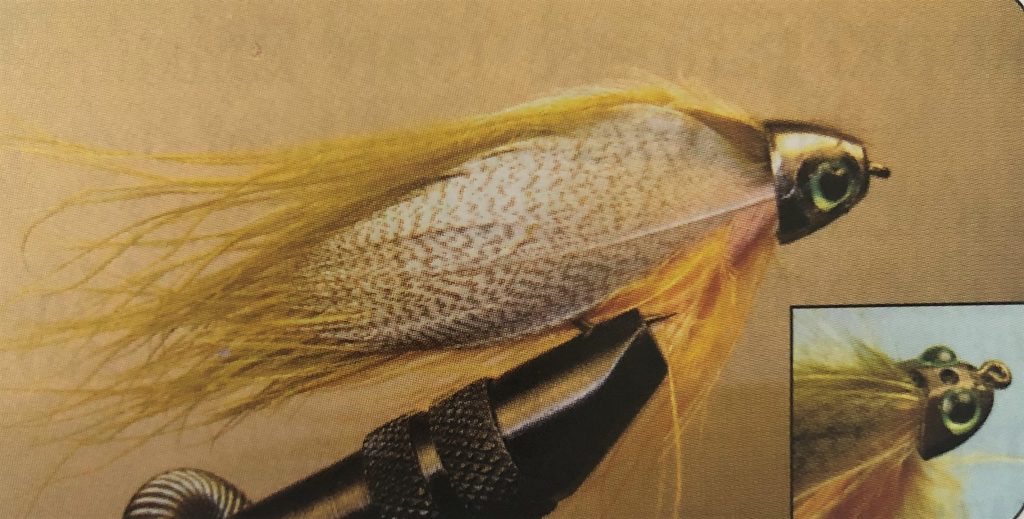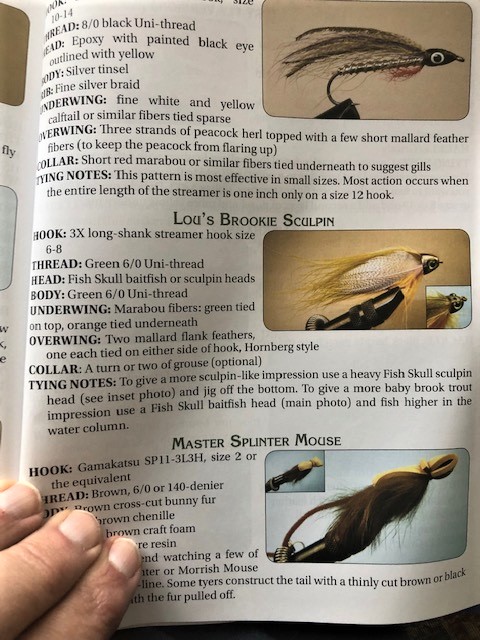I will be giving a presentation to the Fly-fishing club of the University of New Hampshire on March 21st. If you would like to attend, please contact
unhflyfishingclub@gmail.com for more information.
I will also have a table at the annual western Maine fly-fishing event on March 26th Western Maine Fly Fishing Forum. at Gould Academy Fieldhouse on 39 Church Street, Bethel, Maine 04217. I will be selling my books and showing examples of my favorite trophy brook trout flies.
I write a column every other month for the Maine Sportsman monthly newsprint magazine. If you have never checked this publication out, I wholeheartedly recommend it, it is chock full of useful and interesting information. In the November issue, I wrote a column about a new fly pattern that I had some luck with at Upper Dam and elsewhere. It drew quite a bit of attention and so many asked for the recipe that the magazine published it. Since there seemed like such interest, I thought I would post my draft of the original column here along with a photo of the recipe from my book, “In Pursuit of Trophy Brook Trout”. Here it is:
A kaleidoscope of yellow and red leaves swirled down from the tops of birch and maple trees as I drove a western Maine logging road. Peak color was on the wane, and all but the aspens would be bare-branched soon. October’s bird season appeared in full swing on this Saturday. Every few minutes I passed a truck parked roadside, or the bird hunters themselves outfitted in blaze orange as they walked the side woods roads cradling their shotguns, sometimes with bird dogs sniffing ahead of them.
But no leaf-peeping or bird hunting for me, I continued on my way to Mooselookmeguntic Lake’s famous Upper Dam for a little late-season fly-fishing. Like any addict, I try to secure my angling fix before winter’s ice make me go cold turkey for months. I parked my car at the gate and briskly hiked down the hill to the dam. I was fully outfitted with waders, over-stuffed vest, wading staff, and two fly rods; my 10-foot nymphing rod and my seven-weight streamer rod.
Upper Dam
As I drew closer to the dam, I walked past an old apple tree. Suddenly, a half a dozen grouse exploded from within its yellow-leaved branches and flew across the open field. “How ironic after passing all of those hunters”, I said to myself, “If I had been walking with a shotgun, instead of a fly rod, I might have bagged two grouse.” But I was after creatures with scales, not feathers.
It was a decent day for the 2rd week in October; a slight overcast with a breeze running up the river channel (as it often does) and temps in the low 50s. Given the moderate weekend weather, it did not surprise me to see a full contingent of anglers in all the usual and productive places – I counted 12. But low water levels allwed me more room to roam. So, I crossed the dam bridge, meandered down the far shore, and then made my way through the rocks and small runs out towards the backside of the main flow, downstream from the main pool.
It took me awhile to get into position. I am cautious now as I approach social-security age, and deceptively strong side-currents, an unstable rock, or an unseen hole could cause a stumble that might screw up a knee or an ankle. Better to go slow, and use a good wading staff with a metal tip.
I arrived at my mid-river destination and the closest angler stood over 70 feet away and on the other side of the main current. Once in position, I lay my staff and rods on two convenient flat-topped rocks, and considered my options. I could high-stick nymph fish, and use the length of my rod, two nymphs, and adjustable split shot to probe deep underneath the many rocks and boulders within reach that divided the lively current. I could also attach a strike indicator and cast further up or down river to cover more territory.
Proven Tactics
If nymphing, my patterns had to imitate what was available to the fish. Most caddis and mayfly larva are small at this time of year, so a match would be hook size 16,18, or 20. If I want my point fly to be heavier to better sink in the faster flows, I often choose a larger stonefly nymph imitation, since their multi-year life cycle produces larger nymphs year-round.
Alternatively, I could grab my streamer rod already rigged with a weighted streamer to fish across and down the main current or probe the deeper and slower water of the lower pools. In the fall, salmon and trout are deep in spawning mode and will attack colorful streamers that they see as either rivals to drive off or distracted younger brethren to grab for a cannibalistic meal.
I decided to begin by high-stick nymphing, with a size-10 black stonefly pattern of my design called (Sim’s Stone) and a size-18 beadhead pheasant tail. After a few drifts without a take, I added a split-shot to deepen the drift. On the second cast near a refrigerator-sized boulder, I had a strong take from a big salmon that surged in the strong current and broke me off. When you are fishing 5x tippet and small flies, that happens sometimes.
Nymphing the rest of the run, I brought several salmon and a brightly colored brook trout to hand – but of course – none as big as the first one.
New Patterns
I then switched to my streamer rod because I wanted to experiment further with a new family of streamer patterns I had developed for my “In Pursuit of Trophy Brook Trout” book. These streamers feature the spawning brook-trout colors of green, orange, and red but we tie them with Fish-Skull brand weighted heads. The combination has proven effective for hooking pressured trout that have seen the more traditional streamer patterns and no longer react to them.
On my second cast into a deep hole outside of the main current, I felt a tug and then a fish exploded into the air. It was so broad-shouldered and dark, I thought for a moment it was a smallmouth bass, but since smallies haven’t invaded here yet, I prayed that wasn’t the case. It turned out to be an old, scarred, but still powerful salmon that probably weighed four pounds. My fly continued to nail salmon for the next hour. I have no idea why landlocks were hammering a brook trout imitation. Do salmon feed on baby brook trout? Do baby brook trout predate salmon redds? Trying to explain the continuing mysteries of fly-fishing keeps me captivated.
October Options
Upper Dam is one of a number of Maine October river-fishing options. Try the Presumpscot, Saco, and Mousam Rivers in southern Maine, the East Outlet by Moosehead Lake, or the Fish River for landlocks below Fish River Falls (just to name several good options). Always double-check regulations.
Extend your season into October and later. Winter’s enforced fly-fishing celibacy will be arriving soon enough.
I would like to remind folks that my trophy brook trout book includes descriptions and recipes for all of the “guide’s flies” that I used to target trophy brook trout all over Maine for years. You can purchase directly from me signed or from other retailers such as Amazon, Orvis, the Rangeley Fly Shop, Royal River Books, and Shermans in Windham.


